|
|
Expedition
Expedition | People
|
Log - August-11-2003
by Gerhard Behrens and Robert McCarthy
Previous | Next
Walking on the land
Robert McCarthy |
| See my log from August 3rd “Heroes Down Under”! No, really, see my log from August 3rd! These divers are Heroes! Now see my log from August 6th, “Ride of a Lifetime” (different ride, but same sentiments.) And finally see my log from July 28th, “Thank you, thank you, thank you”. All of those were rolled up into one fantastic journey yesterday. Gerhard Behrens and I were privileged to accompany Drs. Humfrey Melling and Helen Johnson on a small boat excursion to Offley Island, just north of Petermann Glacier, to place a shallow pressure sensor mooring down about 60 feet. Let me just say that Petermann Glacier is impressive. It is about 10 miles across, between two huge walls of rock (Petermann Fjord), and it extends about 60 miles into the Greenland Ice Cap. We spent the morning heading into Petermann Fjord, and then I got “the call”. The call to the bridge for the small boat operational briefing. Another chance of a lifetime; one I’ll never forget. |
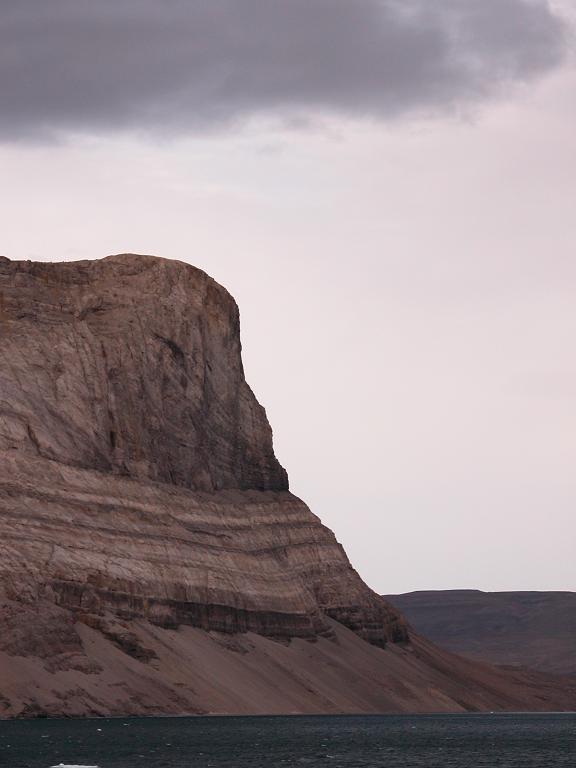 |
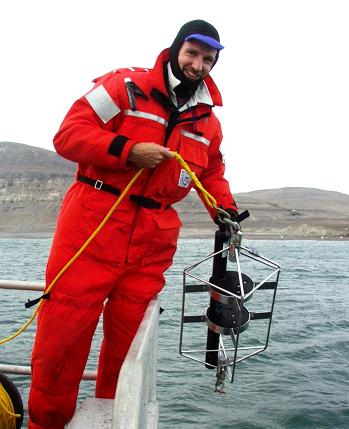 |
After dinner, we got suited up in the Mustang suits, and climbed down the 30-foot ladder to get on the Healy 3, the small boat. The wind had been blowing all day (coring operations postponed due to too much wind), and the waves were about 3 feet, but on the small boat they seemed more. The boat powered away, and the ride was awesome. We were heading into the waves, and every so often, we hit a wave just right and “caught a little air”, and came crashing down. The wind and the spray, it was definitely fun! |
| Getting near the rocks, the immense size overwhelmed me. The layered rocks and the erosion from years of scourering by glaciers were amazing. When we got behind Offley Island, the waves died down, and they pulled the Healy 3 into a region that Humfrey had scouted out from the helicopter a few days before. Placing the camera down, we could see a rocky bottom that sloped too steeply for the pressure mooring. We pulled up the anchor and brought back to the surface large leaves of kelp. Kelp like a hard bottom substrate to attach themselves to, and so we moved on. The next stop appeared better from the camera. It almost reminded me of snow; it looked smooth and white, and we could see shrimp swimming away. Here’s where things got intense. |
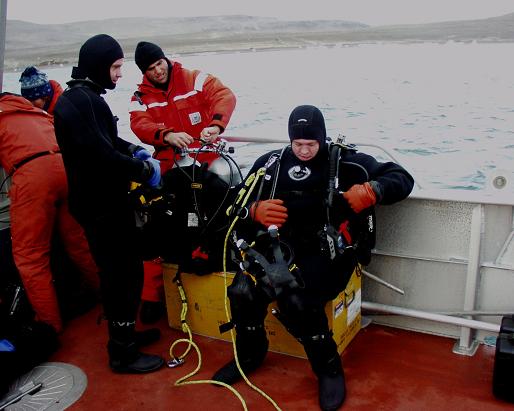 |
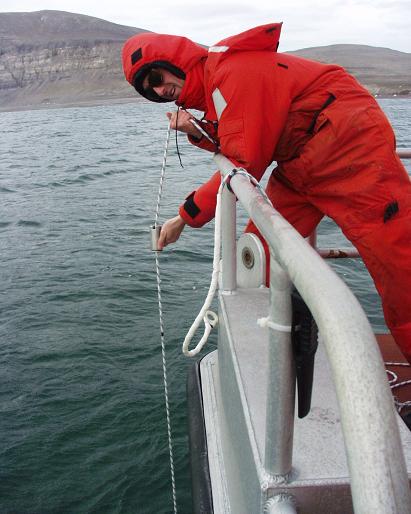 |
The dive crew started to get Todd Gillick and Dave Grob (“G”-Rob) suited up. Everything had been packed with care, and getting the dry suit on was a feat in itself. Each diver had a double tank on his back, with an extra regulator in case of difficulty. The hooded mask tried to keep them dry, but they say their heads get wet anyway. Imagine jumping in knowing that the water temperature is in the low thirties. Fear was not shown, but you could tell the divers were getting focused, and going through the dive in their heads. Todd was the first in, and he went down the anchor line to start the mooring base that has to be driven into the bottom to hold the mooring secure. Dave was next, and when he jumped in, his air started leaking. It turned out to be fine, but everybody was on edge at this point. Neil Amaral was the dive commander, and he could talk to each diver from above, but the divers couldn’t hear each other. This is where it got very TENSE! Waiting for replies and not knowing what was happening down below, it got very quiet. The bottom proved to be too soft, and after a 30-minute dive, Neil called the divers back. He didn’t want them down any longer, and thought that the bottom was not suited for a secure mount. |
| When they came up, you could tell that they were frozen---hands lose dexterity first, and then it’s hard to work. After getting their packs off, they went into the cabin to warm up. You could tell they felt bad, but they had no control over the bottom conditions. Then Humfrey had to make another crucial decision (he’s had to adjust his plans more than once on this cruise, and has stayed collected), where to next? After some careful thought, he chose another place to investigate. The camera was sent down again, and this one looked like a happy medium between the two previous locations. Now it was the other two divers’ turn. Neil didn’t have his suit with him, and Todd’s didn’t fit, so he asked if Todd would go down again. That’s exactly what Todd was hoping for. A chance to do it again. AMAZING! It wasn’t anybody’s fault the last dive wasn’t successful, but he wanted another chance to get that mooring in for the scientists. Suzanne Scrivens (“Scribbles”) then got suited up. I was cold just watching them. Neil got out his dive manual, and was calculating Todd’s next repetitive dive. The U.S. Navy Dive Manual has charts for repetitive dives, and Neil was extra careful for Todd’s wellbeing. Neil has a tremendous responsibility to keep his divers safe; one he takes very seriously. The other divers know this, and that’s comforting to them. |
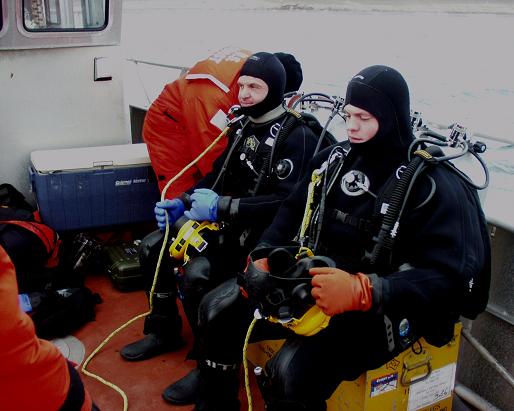 |
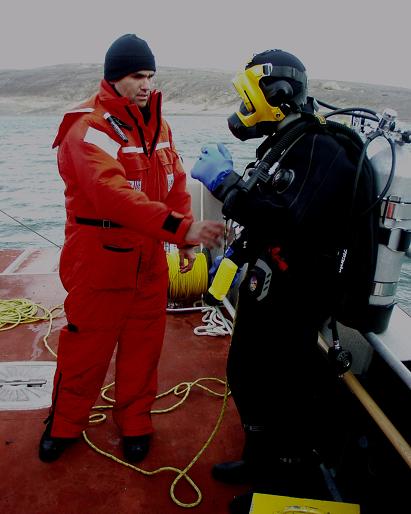 |
This dive then went extremely well, and Todd was busy getting the mooring into the seabed when Suzanne went in. Her hood was not part of her dry suit, and water rushes in immediately, and then her body warms the water next to her head. Think of ice-cold water on your head---guts! She went down, then once Todd had the mooring post secured to the bottom, Humfrey and Helen sent down the instrument package. Suzanne and Todd worked well together, and they both came up in about 20 minutes. SUCCESS! |
| Between dives, Dale Hubbard, from Oregon State University, had some water samples to collect. He brought a Niskin bottle along, and he took a water sample the “old-fashioned-way”, by hand. He opened the bottle, sent it down by hand, and sent a weighted “Messenger” down the line to trip the bottle release. That was fun and he enjoyed it too. Also, Dr. Andreas Muenchow wanted me to make a few CTD (Conductivity, Temperature, and Depth) casts between dives. I lowered the sensor in the water, and Dale and Gerhard helped me bring it back up. Mentally, it justified my being on the boat, but really we were just there to watch and document their dive. |
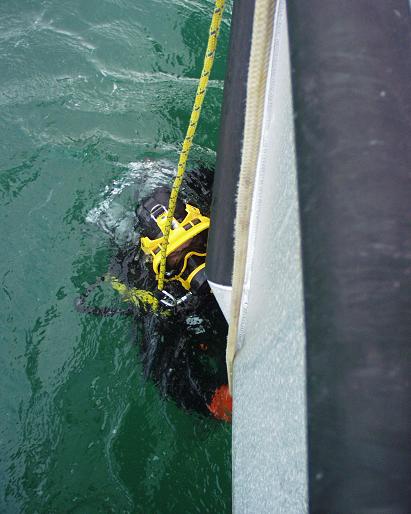 |
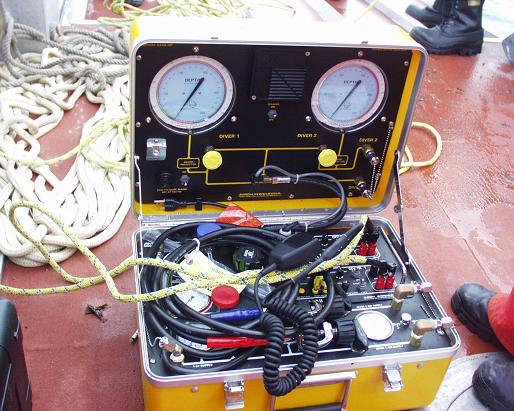 |
BUT, our ride still wasn’t over. Dale luckily was with us, because he needed to get a freshwater sample from a stream that drains directly from the Greenland Ice Cap! So they drove the small boat right up to the beach. While Dale went for his sample, we were able to get off and walk around the beach area until Dale returned. That was a welcomed experience, walking on land! I was like a boy again, walking along the water’s edge looking for special stones and shells to bring back as souvenirs for my family. Thanks again to the Principal Investigator, Dr. Kelly Falkner for giving me “The Call”, and to all who were on the boat that made the excursion unforgettable. |
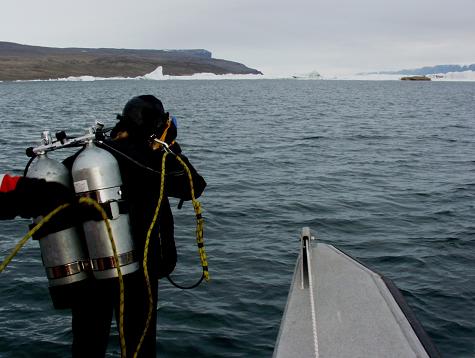 |
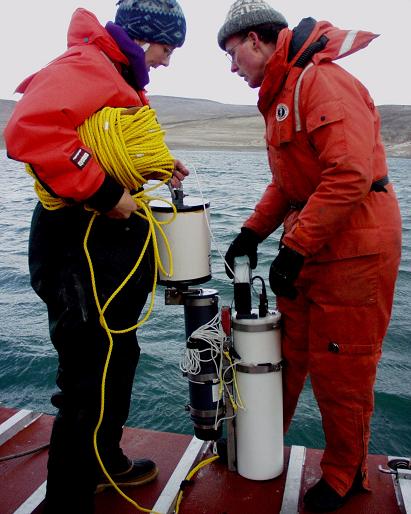 |
| Please read Gerhard Behrens log entry for this day for more details of our trip, and complementary photos. |
Not just any boat ride
Gerhard Behrens |
| Cruising the waters of the Arctic in a 420 foot Coast Guard icebreaker, how cool is that? Observing leading scientists doing their work, how interesting is that? Buzzing the cliffs and river valleys of Ellesmere Island in a sleek rescue helicopter, can it get more exciting than that? Uhhh…..maybe! |
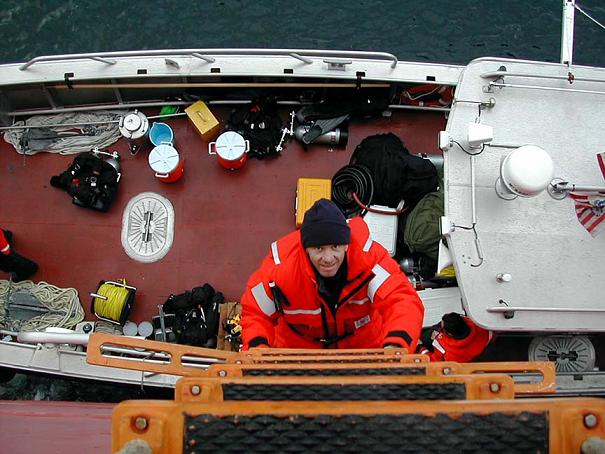
Climbing down to the boat started the excitement. |
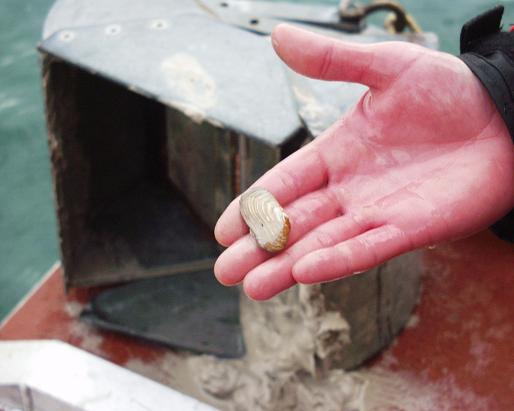
A clam find, another for our scientific collection. |
Yesterday evening, I spent 6 incredible hours in a 25 foot aluminum boat with 3 scientists, 5 divers, and 4 crew, and my fellow teacher, Bob. Everything about this trip was a highlight. Everything! |
| First, you get to bundle up like an astronaut: a couple of layers of warm clothing, big boots, and a Mustang Suit: a full length, windproof, waterproof outfit filled with insulating foam. Then, you climb down the sheer face of the ship, 30 feet, on a rope ladder, into the boat below. |
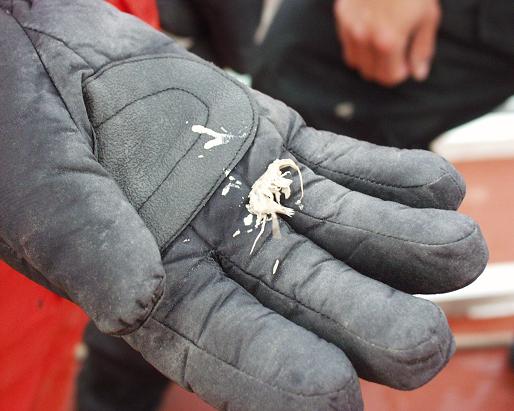
Surprise, a shrimp from the mud. |
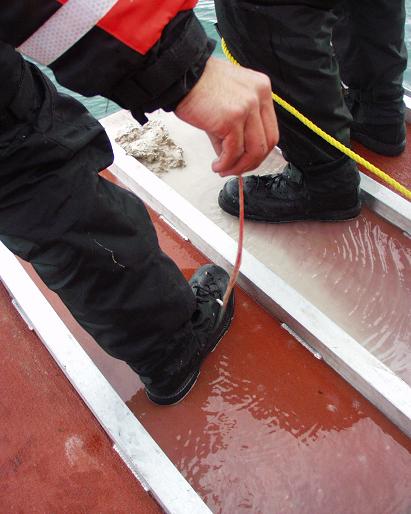
Another surprise, one of many sea worms. |
When the boat takes off, the fun really starts. We rip over the surface of the water, sometimes smooth as silk, other times like we’re riding a bull at the rodeo. The coxswain, (pilot of the boat) BM2 Geist, is totally under control, so it’s a wild ride, but very safe. We arrive at our first location, about 2 miles away from the ship, ready to do some science. |
| That turns out to be just as interesting and fun. Humfrey Melling and Helen Johnson lower a video camera in the water and start searching for a good place to put in a “shallow mooring.” This mooring, like others we have placed, will help the scientists understand how much water comes into this area by measuring the pressure: more water, more pressure. They plan to place the mooring about 20 meters (60 feet) deep. |
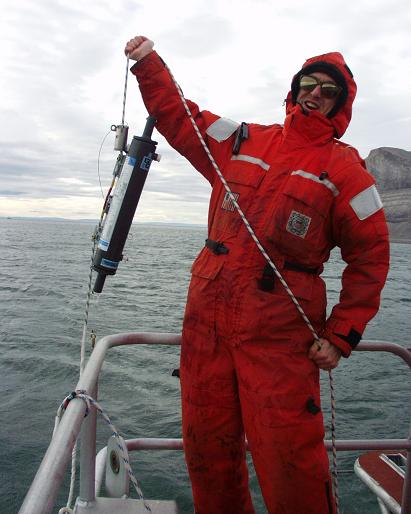
Dale took water samples by hand: a rope and a bottle. |
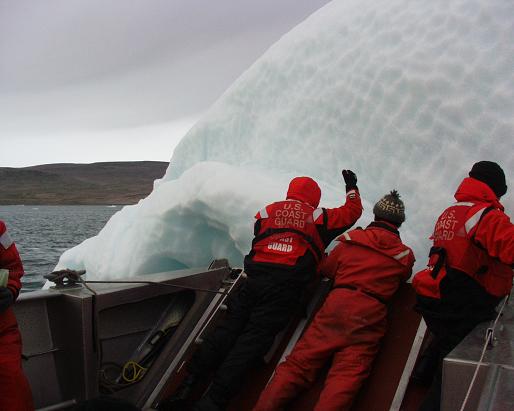
After the diving, we took iceberg samples. |
After throwing the anchor overboard a few times, we realize the bottom is too steep and too rocky to attach a mooring. We move to a second site and find it is muddy, a good sign. The divers get ready to go down, and the crew brings up a sample of the seabed: mud (kind of neat), a clam (good for more research), worms (wow!), and a shrimp (amazing). The divers go to work, 65 feet below us, in 0°C water (32-33°F). After nearly 30 minutes (can you believe it?), they have to come up, and they tell us the ground is too soft to place the mooring. |
| We check out two more sites until we find one that is, as the famous bear says, “Just right.” More hard work by the crew and the divers get the mooring in place. It is a big team effort: pilot the boat safely, anchor safely, get the diving gear on safely, dive safely, and handle the heavy equipment safely. |
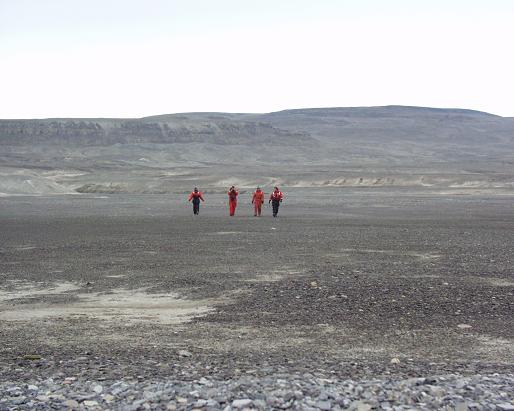
Dale walked a mile for a water sample from a river. We all enjoyed the big, broad beach. |
| In the meantime, Bob McCarthy, the physics teacher, takes measurements of the temperature and saltiness of the water. Dale Hubbard gets water samples the old-fashioned way: throw a bottle over the side using a rope with meter marks, and close the bottle with a weight that travels down the rope. |
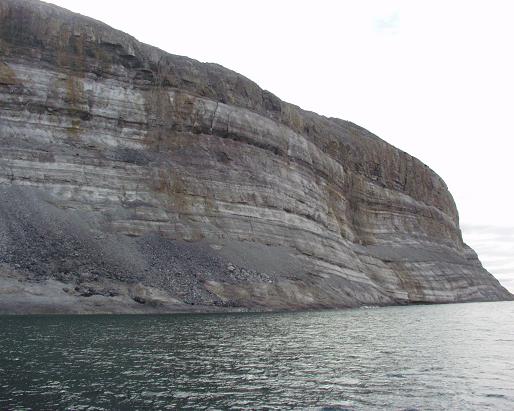
A background of beautiful cliffs. |
All that excitement and it still isn’t over. We put the bow of the boat right on an iceberg and collect samples for scientists back on the ship. Everyone munches a mouthful of this ancient, pure ice. Next, our expert pilot nudges the bow of the boat on a beach. Dale Hubbard takes a long walk to collect river water samples. The rest of us are little kids Again. We collect rocks, find bones, look for shells, discover animal tracks, skip stones, marvel at the glaciers and cliffs, and enjoy the peace and quiet of the beach. |
| The only bad thing about the ride back is how short it seems. |
| I wrote that the helicopter ride helped me see the ship and our science work with new eyes. From the taste of an iceberg, to the spray on my face, to the crunch of rocks under my boots, to the smell of the divers’ wetsuits, this boat trip helped me feel the trip in a new way. |
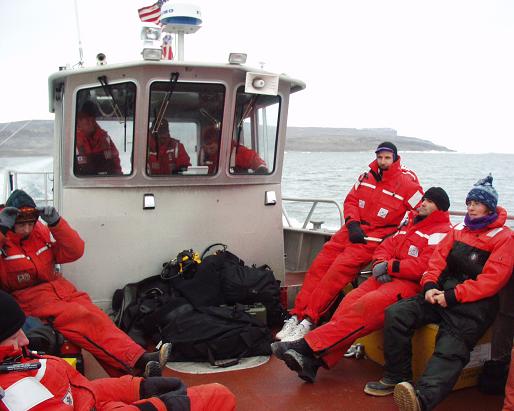
The ride out and back was great, thanks to the Mustang Suits, and the crew. |
| Make sure to check out Bob McCarthy’s story for today, August 11, for his description and more pictures. |
|
